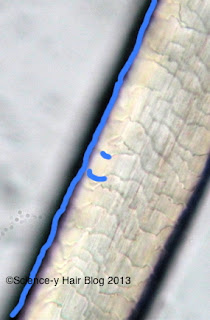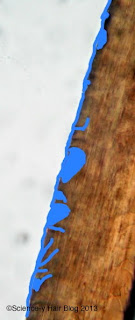Protein is in hair products because it can repair and strengthen damaged hair. If you read on the internet and forums, there are many theories about protein. For example, low porosity hair should use only small protein. But is this correct? Is this even scientifically substantiated and why do we actually use protein?
In this blog we tell you more about protein and what the best products with protein are. It's not a black and white story; So we can't tell you exactly at the end of this article whether protein will work for you or not (although this is often done). However, you can learn more about it so you know how to experiment with it. Because there is one fact, and that is that there are different types of proteins.
Why do we use protein?
Our hair consists mainly of protein (also called keratin). These are also the building blocks of, for example, our skin and nails.
Protein has been used in hair products for a long time. For example, you can also find protein in food. In nutrition we often talk about large types of protein and when a protein is divided into smaller pieces we call this hydrolyzed protein. The latter is often found in hair products. Manufacturers do this because a 'whole protein' often cannot penetrate our hair, while hydrolyzed protein can.
Basically, adding protein is intended to make the hair stronger, shinier and more hydrated and to repair damage.
Basically, protein does the most for hair that is very damaged (often highly porous). In other cases, large proteins often work as a conditioning agent (puts a layer around the hair to protect it, among other things) and small proteins can penetrate our hair and, for example, make the hair stronger.
But how exactly do you know if you need protein? It's a complicated story. Because did you know that it is very difficult to determine whether your hair is porous? And did you know that it is not always equally porous in all places?
How do you recognize protein in hair products?
You can recognize protein by looking at the ingredients list of your hair product. Search for one of the following terms:
- Hydrolyzed Wheat, Corn, Pea Soy etc.
- Hydrolyzed Keratin, Collagen, Silk
- Amino acids
You can also use sites like isitcg.com to find out if your hair product contains protein. You can also look up your product on our website; We have indicated for each item whether it contains protein or not.
Why should you use protein?
Protein is used by manufacturers and brands to make your hair stronger, shinier and less brittle. It also provides extra hydration. Do you have damaged hair? Do you dye your hair or has your hair been chemically treated? Then the protein may make your hair stronger.
You can see in the image that the protein fills the highly porous hair, so to speak, and this allows your hair to become stronger and it also forms a layer around your hair.
Protein does the following for low porosity hair (left photo) and for high porosity hair (right)


Protein is actually a conditioning agent. It can adhere well to the hair and on the other hand it can make your hair stronger, soften and give it shine. Protein contains no waxes or oils, making it a perfect ingredient to care for hair without weighing it down. In addition, protein also ensures that your hair can absorb moisture better and retain it well.
Who needs protein?
In general, the following characteristics indicate that you can use protein in your routine:
- Finer hair to medium thickness can benefit from protein, it can give your hair more strength.
- Hair that has been bleached or has highlights
- Chemically treated hair
- Hair that has been brushed excessively too often
- Hair that often comes into contact with chlorine or salt
- Hair that is often exposed to the sun
- Dry hair
- Hair on which heat tools such as a hair straightener have often been used
- Fragile hair
- Sagging hair
What types of protein are there?
When talking about proteins, it is important to divide them into two types based on molecular weight:
These are often hydrolyzed protein and amino acids. These proteins are smaller and can possibly penetrate our hair. They can therefore improve your hair and make it stronger.
What kind of protein do I need?
Large protein often acts as a 'film former' and can help you retain moisture in your hair. Smaller proteins can penetrate into your hair.
As a rule, it is often said that large protein is suitable for highly porous (more damaged) hair.
You can recognize 'larger protein' (useful mnemonic, the 'edible') by:
- hydrolyzed wheat, soy, rice, quinoa
- Gelatin
Generally suitable for:
- Higher porosity hair (more damaged hair)
- Fragile hair
- Fine/medium thick hair
- Dyed/bleached hair
You can recognize Small Protein by:
Small proteins are best absorbed in a hair mask by using a heat cap.
- Amino acids
- Peptides
- Hydrolyzed silk, keratin, colleges
Generally suitable for:
- All types of hair (from fine to thick)
- High, low and medium porosity hair
How do I incorporate protein into my routine?
Start slowly by applying protein to your hair products. You really don't have to use everything from A to Z in your hair care with protein. Unless you have really damaged hair. But, in practice this hardly happens.
- Want to start adding protein to your routine? Then start with a hair mask . You let it soak in for a long time.
- Do you want to add more protein to your routine, is your hair extremely damaged or falling out? Then do this slowly and add it to your leave-in . Keep an eye on your hair!
What are the disadvantages of protein?
More and more chemists are surprised by the 'yes or no protein story'. Heleen Kibbelaar (Instagram: ScienceMeetCosmetics) describes the following. The use of protein in hair products is a hype and is used by manufacturers because our hair consists of protein and it can be broken down by chemical treatments, bleaching, etc. The solution? Products with protein.
But, Heleen writes, it is difficult to solve this damage with protein as each protein has a unique composition and a different mechanism is needed to repair and protect the hair. Take cationic ingredients for example, these are ingredients that can protect your hair against frizz and make the hair shinier, smoother and provide protection. These ingredients are 'positively charged' and our hair is 'negatively charged', which means they can bond well with each other. They place a protective layer around the hair.
That is why Heleen indicates that protein is not only necessary to repair the hair. Because there are other conditioning agents that, just like protein, also coat the hair to protect it and may even do this better than protein. And therefore indicates that it is better to focus on conditioning agents other than protein. In short, for brittle and damaged hair, make sure you use products with the right conditioning agents.
Finally, Heleen indicates that it is also difficult to know exactly the porosity of your hair. Your hair may be more porous at the ends than other parts of your hair.
Conclusion
Do you have brittle, damaged or dyed hair? Then your hair can benefit from protein, but make sure you also pay attention to how you feel after using the conditioner or mask: does it not feel soft or smooth? Then find a different conditioner. So you can also pay attention to high protein. In addition, it is important to leave your hair alone as much as possible: don't brush it too much, don't touch it too much and see how your hair reacts to certain products.
Moreover, it is always important to keep an eye on your own hair. If one protein does not work, this does not necessarily mean that it will not work for you (even if you both have the same hair properties).
And finally, it is always important to keep an eye on your own hair. If one protein does not work, this does not necessarily mean that it will not work for you (even if you both have the same hair properties).
3 tips for the best products with protein

The Curlsmith Bond Salve is a treatment. This means that you do not always have to use it, but occasionally (think for example once every 2, 3 or 4 weeks). This product contains protein and is able to penetrate the hair and repair the sulfur bridges (which may be broken).

Still unsure about adding protein to your routine? Then this product is recommended. You can use it in 3 ways: as a mask, conditioner and leave-in.
3. Curlsmith Multi-Tasking Conditioner

Do you want to see all products with protein? Then take a look at this special collection . For this blog we used publicly shared information from Hair Science Blog and @SienceMeetCosmetics and Georgina Stanciu.





